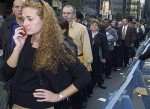There’s a reason Obama’s economy and so-called recovery is referred to as the recoverless recovery. For much the same reason that drops in the unemployment rate don’t mean that we are creating jobs.
This video illustrates the performance of the last eight recessions and why the last three all look different.
In Obama’s jobless recovery, the unemployment rate is going down. Not because more people are working, but because fewer people are working. 296,000 less in February than in January. The BLS simply shrinks the job universe of workers, referred to as the labor force participation rate, before computing the unemployment rate. It is as though those unemployed whose 99 weeks of unemployment have run out, and are still unemployed, have died. The government stops counting them.
This is how the BLS describes it . . .
The civilian labor force is the sum of employed and unemployed persons. Those persons not classified as employed or unemployed are not in the labor force. The unemployment rate is the number unemployed as a percent of the labor force. The labor force participation rate is the labor force as a percent of the population, and the employment-population ratio is the employed as a percent of the population.
- When you include those unemployed as still living, the real unemployment rate, the U-6, is 14.3%.
- Multiple job holders, those needing and getting two or more jobs, grew by 340,000 since January 2013.
- There are 1,129,000 fewer workers in the work force in February 2013 than in February 2012.
- The number of unemployed that have been unemployed for 27 weeks or over increased by 89,000 from January 2013.
- Unemployment rate for “Black or African Americans” ages 16 to 19 years old went from 37.8% in January to 43.1% in February 2013. Same age bracket for “White” was 20.8% in January and 22.1% in February 2013.
The “highlight” that The White House and the media report is “Total nonfarm payroll employment increased by 236,000 in February, and the unemployment rate edged down to 7.7. And, that 236,000 number includes second and third jobs found by the still employed. And, when you consider that due to retirements and population growth, a break-even in job creation would be 250,000 jobs per month, that we not only have a recoverless recovery, but a jobless recovery as well.
The details are here . . .
